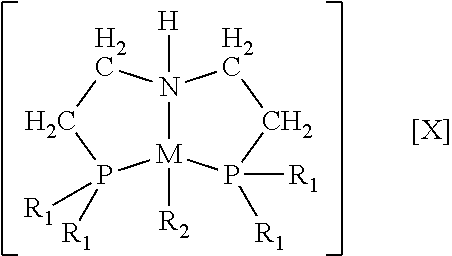Catalytic hydrogenation using complexes of base metals with tridentate ligands
a technology of tridentate ligands and complexes, which is applied in the direction of hydrocarbon preparation catalysts, group 3/13 element organic compounds, chemical production, etc., can solve the problems of limited substrate scope and restricted effect of such complexes, and achieve the effect of reducing the number of substrates
- Summary
- Abstract
- Description
- Claims
- Application Information
AI Technical Summary
Problems solved by technology
Method used
Image
Examples
embodiment
[0028 complexes of cobalt and of nickel were synthesized and used for catalytic homogeneous hydrogenation of unsaturated compounds. Embodiment cobalt complexes include cobalt in the +2 oxidation state (i.e. cobalt(II)) and the tridentate ligands bis[2-(dialkylphosphino)-ethyl]amine (HN(CH2CH2P(R)2)2 (“PNHPR”, where R=cyclohexyl, alkyl, substituted alkyl, phenyl, or substituted phenyl). These bulky ligands are sometimes referred to in the art as “pincer” ligands. The hydrogenation reactions using these embodiment cobalt complexes take place under relatively mild conditions. Embodiment complexes of nickel with the PNHPR ligand were also prepared and used for catalytic homogeneous hydrogenation of unsaturated compounds. Some embodiment complexes that fall within the scope of this invention have the formula
[0029]
[0030]wherein R1 is selected independently from cycloalkyl (e.g. cyclohexyl, adamantyl), alkyl, substituted alkyl, phenyl, or substituted phenyl;
[0031]wherein R2 is —CH2Si(CH3)3...
PUM
| Property | Measurement | Unit |
|---|---|---|
| pressures | aaaaa | aaaaa |
| temperatures | aaaaa | aaaaa |
| temperature | aaaaa | aaaaa |
Abstract
Description
Claims
Application Information
 Login to View More
Login to View More - R&D
- Intellectual Property
- Life Sciences
- Materials
- Tech Scout
- Unparalleled Data Quality
- Higher Quality Content
- 60% Fewer Hallucinations
Browse by: Latest US Patents, China's latest patents, Technical Efficacy Thesaurus, Application Domain, Technology Topic, Popular Technical Reports.
© 2025 PatSnap. All rights reserved.Legal|Privacy policy|Modern Slavery Act Transparency Statement|Sitemap|About US| Contact US: help@patsnap.com



